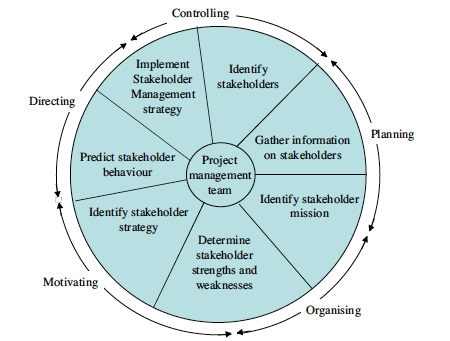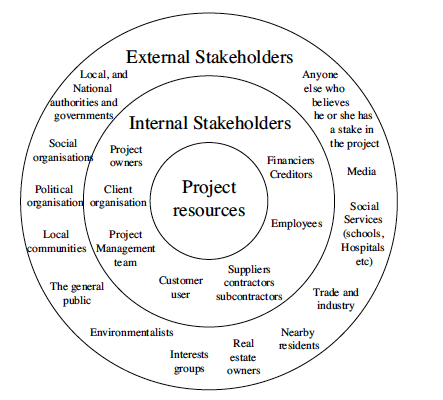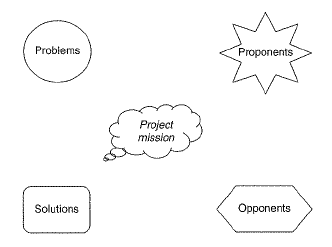Managing Stakeholders in Construction
This article focuses on managing stakeholders in the construction process. There are in complex construction projects many different stakeholders that are to be kept satisfied during the entire project. This article focuses on the different management tools that can be applied to managing the stakeholders and their requirements. The article contains a literature review that identifies and reviews the different articles and books used in the article. Furthermore a detailed section of the different management theories about stakeholders are presented. These theories include the general definition of stakeholders and the importance of identifying these different stakeholders in a construction project. It also includes the theory about classifying the stakeholders and comparing them internally as a management tool. Different management solutions are presented, such as stakeholder mapping, stakeholder salience and framework solutions. In the solution of mapping stakeholders, the impact/probability-matrix is defined as an important tool in managing the stakeholders. Furthermore the theory behind stakeholder salience is presented as the model that can help the project manager to identify the important stakeholders, to which the project manager should pay close attention. The final solutions that are presented are the different framework solutions that can be used for implementing the stakeholder management tools in projects. The recommendations based on the studies for this article are more digital solution that could combine stakeholder requirements in construction with the building information modelling. The article concludes the importance of the identifying, classifying and mapping the different stakeholders in construction projects. The frameworks presented in the article are not fully comprehensive, but there is a future in developing new methods for managing stakeholders in construction projects.
Contents |
Overview
The project stakeholders are those actors that will incur – or perceive they will incur – a direct benefit or loss as a result of the project. (Winch, 2010). A project stakeholder is defines as an “individual or group who have an interest or some aspect of rights or ownership in the project, can contribute in the form of knowledge or support, can contribute in the form or can impact or be impacted by the construction project. (Aapaoja & Haapasalo, 2014) It is the project manager’s role to manage the stakeholders in a construction project and ensure that they are satisfied so that the project can be completed without delaying the project or going over budget. Dealing with stakeholders as a project manager means having a role as a facilitator among different constituencies, as well as ensuring the project requirements are fulfilled satisfactory conditions for all parties. Project stakeholder management is the systematic identification analysis and planning of actions to communicate with and impact stakeholders (Aapaoja & Haapasalo, 2014). As a project manager several tools and methods can be used when dealing with a construction projects stakeholders. The tools are applied to avoid uncertainty in the project, as some stakeholders can have a lot influence on the success of the project. Stakeholders’ ads complexity to a project, and it requires planning from the project manager and in developing the processes the project managers’ role is important. The element of complexity regarding the stakeholders often involves a large number of stakeholders with different requirements, and the interference in the project by key stakeholders. It can also mean the opposite that key stakeholders show little interest in the project, which also can be a challenge for the project manager. (Maylor, 2010)
Stakeholder Management
Project stakeholder management in constructionis the systematic identification, analysis and planning of action to communicate with and impact stakeholders. Stakeholder management is an essential part of the project management process. The process is illustrated in Figure 1. The process consists of executing the management functions of planning, organising, motivating, directing and controlling the stakeholders. (Olander, 2003)
Stakeholder Identification
It is an important tool for the project manager to identify the stakeholders of a project, as one of the first step in managing the stakeholders. It is often useful to categorize the different types of stakeholder before being able to analyse them. Often a number of questions are used for identifying the stakeholders on a project. (Aapaoja & Haapasalo, 2014)
- Who might be affected by the development concern to be addressed?
- Who are the voiceless for whom special efforts may have to be made?
- Who are the representative of those likely to be affected?
- Who is responsible for what is intended?
- Who is likely to mobilize for or against what is intended?
- Who can make what is intended more effective through their participation or less effective by their non-participant or outright opposition?
- Who can contribute financial and technical resources?
- Whose behaviour has to change for the effort to succeed?
Typically in construction one divides stakeholders into internal and external parties. The internal stakeholders are defined as a stakeholder that is in legal contract with the project or finances the project. They can also be defined as primary stakeholders. The internal stakeholders can be broken down to two categories, the demand side and the supply side. On the demand side the client, the financiers and the tenants are placed among others. On the supply side the architect, engineers and the materials supplier can be found among others. The external stakeholders have a direct interest in the project without being legally bound by a contract to the project. The external stakeholders are also described as secondary stakeholders. As well as the internal stakeholders, the external stakeholders can be divided into to two categories – private and public. The private external stakeholders are neighbours, landowners or NGO’s. The public stakeholders are the local and national government. In Figure 2 a lot of internal and external stakeholders can be seen.
There are often a conflict of interest on the demand side and supply side of the internal stakeholders since they compete to appropriate the income stream of the project. The internal stakeholders will more likely be in favour of the project compared to the external stakeholders, who will more likely be against or indifferent (Winch, 2010). Identifying the stakeholders means finding out who have an interest in the project, and who could in the future have an interest in the project. After identifying the stakeholders it is crucial to gather information about the stakeholders and thereby being able to identify their stakeholder mission(Olander, 2003).
Stakeholder Salience
Stakeholder Salience identifies the stakeholders to which the project manager should pay attention. Stakeholder salience is divided into three attributes; power, legitimacy and urgency. The salience depends on the number of attributes that a stakeholder represents. The salience can vary during a construction period. This means that a stakeholder can try to shape their attributes during the project period, so that they can be prioritized. The three attributes power, legitimacy and urgency are what the project manager can use to categorize the stakeholders. If a stakeholder doesn’t posses any of the three attributes, the stakeholder cannot be categorized as a project stakeholder. The first attribute power is defined as the probability that stakeholder X has the power to influence stakeholder Y to do something that stakeholder wouldn’t otherwise have done. The second attribute legitimacy is the assumption that the actions of the stakeholders are within the norms and definitions. Project managers are usually more willing to pay attention to stakeholders who are perceived as legitimate. The last attribute is urgency. This urgency refers to the stakeholder’s urgency in the project, or with other words how urgent does the stakeholder believe their claim is. Urgency is not as compelling an attribute as the other two attributes but it is not to be neglected by the project manager. The stakeholder salience is used in a method developed by Mitchell, Agle and Wood. They divided stakeholders into 7 different categories based on the three attributes. (Aapaoja & Haapasalo, 2014)
- Demanding – The stakeholder have an urgent claim but no power or legitimate relationship.
- Discretionary – The stakeholder have the attribute of legitimacy but they don’t have power or urgent claims.
- Dormant – The stakeholder have the power, but don’t have any legitimate relationship or urgent claim.
- Dependent – The stakeholder posses’ urgent and legitimate claims, but no power.
- Dominant – The stakeholder is both powerful and legitimate.
- Dangerous – The stakeholder is not legitimate, but they have power and urgency.
- Definitive – The stakeholder posses all three attributes.
These 7 categories will give the project manager a tool to identify and assess their salience. These 7 categories will tell the project manager the stakeholders level of impact on the project, but only if they decide to act. The project manager can use stakeholder mapping as a tool to categorize the stakeholders according to their probability to act.
Stakeholder Mapping
After identifying the stakeholders, the project manager can map the stakeholders to try to investigate their interests. In Figure 3 an example of a stakeholder map can be seen. This specific stakeholder map can be used in construction to decide whether or not the stakeholder has a problem with the project mission or if they have a solution to the mission. It can thereby also be determined if a stakeholder is an opponent to the project or proponent. It is one of the most important jobs as project manager to try and turn the opponents to proponents (Winch, 2010).
After the stakeholder map has been created the power/interest matrix can be created. The power/interest matrix can be used to develop a strategy towards managing the stakeholders. The matrix can be seen in Figure 4. The matrix consists of two dimensions – the power of the stakeholder to influence the definition of the project and the level of interest that the stakeholder have. The matrix categorises stakeholders into 4 different types of stakeholders.
The first category is Minimal effort where the stakeholders with low power and very little interest in the project is placed. These stakeholders are groups such as the clients’ customers. This group needs very little attention form the project manager, and does not oppose a large threat to success of the project. The second category is kept informed where the stakeholders have very little power, but a large interest in the project. Those placed in this group are local neighbours and environmentalists. This group needs attention, monitoring and have to be carefully managed by the project manager. The third group is the stakeholders that need to be kept satisfied. This group of stakeholders have a lot of power, but often doesn’t have a particular high interest in the project. This group of stakeholders are the supply side of the internal stakeholders such as engineers and architects. The final group is the key players that have a high interest in the project and has a level of impact. The typical stakeholder in this group is often the client and those stakeholders close to the client, such as the finance. This group of stakeholders need a lot managing. (Winch, 2010) The degree of integration of the stakeholder map will influence the manageability for the project manager. If the stakeholders are placed in far corners of the matrix the stakeholder map is unstable and it will bring challenges for the project manager. If the stakeholders are placed near the centre of the matrix the stakeholder map is considered relatively stable. The dispersion of the stakeholders in the power/interest matrix will give the project manager different options within making decisions and planning the project.
Stakeholder Classification
Under construction
Application
Under construction
Recommendations
Under construction
Conclusion
Under construction
References
Maylor, H. (2010). Project Management. Olander, S. (2003). External Stakeholder Management in the Construction Process. Winch, G. M. (2010). Managing Construction Projects. Aapaoja, A., & Haapasalo, H. (2014). A Framework for Stakeholder Identification and Classification in Construction Projects, 2014(January), 43–55.
Annotated bibliography



